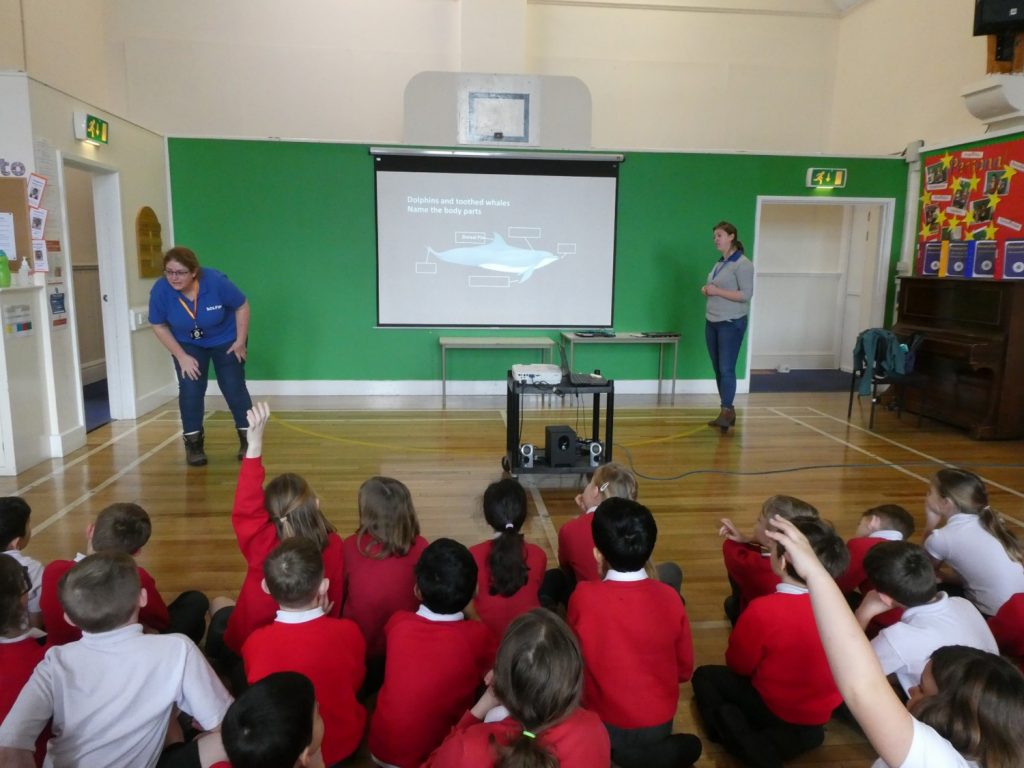The Sea Watch Foundation’s Regional Coordinator for Guernsey, Nicky Harris, has recently visited the Vauvert Primary school in the parish of St Peter port in Guernsey. This is her story!

Liz Sweet (left), manager of the Guernsey Biological Records Centre and Nicky Harris (right), both coordinators of The Bailiwick DolFin Project. The children were very quick to name all the body parts on this dolphin anatomy quiz.
A short note to begin with: Unlike many regions of the UK and EU, the Island of Guernsey in the British Channel is in the unusual position of being almost Covid free, with only 8 cases as of today (Friday 15thJanuary), all contained. While travel out of the Island is almost impossible because of our restrictions, it does mean that schools are open, and our project is in the fortunate position of being able to run cetacean talks face-to-face.
Today our Bailiwick DolFin Project team got to introduce the new Year 3 class at Vauvert to the cetaceans we can see, both in our local waters and further afield. This was the DolFin Project’s first talk of 2021 and after the excellent questions we got asked last year we both studied our dolphin and whale facts. Even though both Liz and I prepared ourselves for our school visit, we were still blown away by the amazing knowledge and insightful questions Year 3 students asked.
The children were so enthusiastic about the local whale and dolphin videos. They loved the quizzes that Sea Watch Foundation sent us. In fact, they easily breezed through the questions on dolphin anatomy and even started teaching us dolphin facts we didn’t know! My favourite new titbit of knowledge taught by a well-informed pupil is that spinner dolphins use the splashes they make after leaps as a form of communication. Sadly, we do not get spinner dolphins in our region, but it just goes to show how smart both cetaceans and the primary students are.
Guernsey has been experiencing a boom in cetacean sightings over the past 5 years or so, especially for dolphin species like bottlenose and Risso’s dolphins. Our small island lies off the coast of Normandy, and as we now realise, is in the vicinity of one of Europe’s largest coastal bottlenose populations. The DolFin Project was set up in response to the increase in sightings to better understand what is happening with our cetacean populations. Public sightings, photos and volunteer surveys all help us fill in our knowledge gaps. The main part of DolFin ID is using photos to identify bottlenose dolphins using their unique fins, so we can work out if our population(s) are resident or are just visiting.

Trevor, one of the bottlenose dolphins in our ID dataset, has quite an obvious nick in his dorsal fin. We know he has been in Guernsey in 2018, 2019 and 2020. Trevor is often seen travelling with 2 other dolphins and we are hoping we can work out if he has been traveling with the same dolphins over the years.
We showed the class of students some of the bottlenose dolphin fins we currently have in our ID catalogue, including Trevor, who has been around Guernsey for at least 3 years. The children took the concept of photo-IDs on-board quickly and scored 100% on the fin ID quiz, so we feel pretty confident these kids will be looking out for Trevor and his friends the next time they take one of the local ferries over to Herm or Sark.
While Guernsey is able to retain a sense of normalcy for the moment, the changeable nature of the Covid-19 means we can’t make plans too far in advance. That being said, we hope to run more volunteer watches this year and we are looking forward to the National Whale and Dolphin Watch (NWDW) week in July.
Author Nicky Harris, DolFin Project Coordinator/ Sea Watch Regional Coordinator
To get in touch with Nicky click here.
To know more about our Education Programme click here.
























